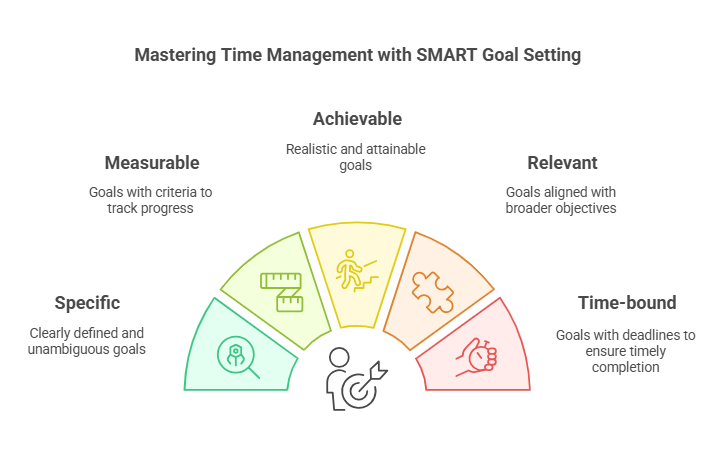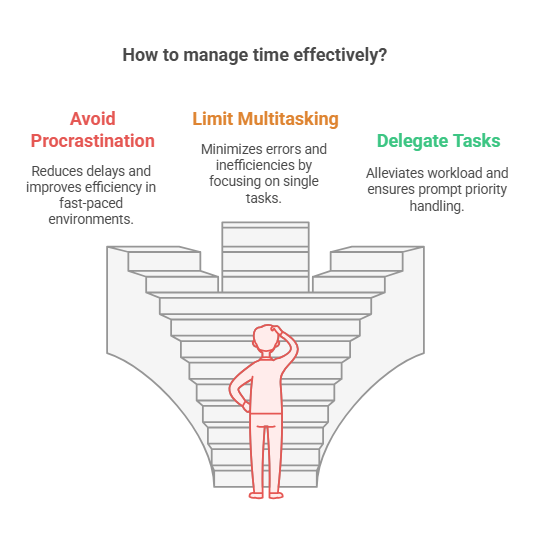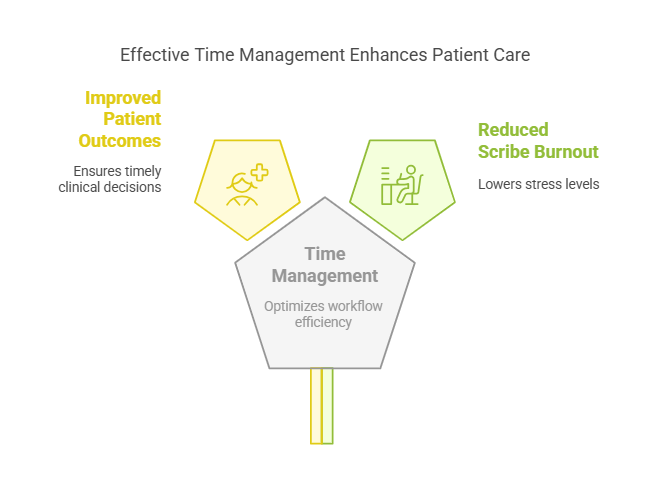What are the time management strategies used by medical scribes?
Medical scribing is a demanding profession that requires a sharp eye for detail, quick decision-making, and, above all, effective time management. In the fast-paced environment of healthcare facilities, medical scribes play a pivotal role in documenting patient encounters, assisting physicians, and maintaining accurate medical records. The job can be incredibly overwhelming due to the numerous tasks medical scribes juggle every day. However, several time management strategies can enhance productivity and streamline workflows, allowing scribes to perform their duties efficiently while maintaining accuracy.
Understanding Time Management for Medical Scribes
Medical scribes often find themselves in high-pressure situations where every second counts. From transcribing physician notes to updating electronic health records (EHR), the demands of the job are non-stop. Effective time management is essential not just for completing tasks promptly but for ensuring the accuracy and quality of the work produced. With so much on the line, scribes need strategies that help them stay on top of their workload without feeling overwhelmed.
Prioritizing Tasks
A core principle of time management is prioritization, and this is particularly important for medical scribes. They must differentiate between urgent tasks that require immediate attention and important tasks that are essential for long-term goals. Utilizing techniques such as the Eisenhower Matrix—categorizing tasks by urgency and importance—helps scribes allocate their time more effectively, ensuring that critical tasks are addressed first and allowing them to stay organized throughout their shift.
Leveraging Technology and Tools
In today’s digital age, technology plays a significant role in helping medical scribes streamline their tasks. Several tools are available to support time management and increase efficiency in healthcare settings:
Electronic Health Records (EHR) Systems: These systems provide a seamless method of documenting and retrieving patient information, significantly reducing the time spent on administrative tasks.
Speech Recognition Software: By enabling scribes to dictate notes directly into the system, this technology eliminates the need for time-consuming manual typing.
Mobile Apps for Task Management: These apps assist scribes in staying organized and managing their workload efficiently, even when on the go.
Setting Realistic Goals and Deadlines
Clear, achievable goals are an essential aspect of time management. Medical scribes can benefit from the SMART goals framework, which helps set goals that are Specific, Measurable, Achievable, Relevant, and Time-bound. By breaking down large tasks into smaller, more manageable steps and assigning realistic deadlines, scribes can stay focused and motivated while ensuring they don’t miss any key aspects of their job.
Implementing Structured Routines
Consistency is vital for maximizing productivity. A structured routine that includes a well-organized daily schedule is crucial for medical scribes. By allocating specific time blocks for various tasks, scribes can stay on track and avoid distractions. It’s also essential to incorporate regular breaks to prevent burnout. Periodically reviewing and adjusting routines can help identify inefficiencies and allow scribes to continually improve their workflows.
Overcoming Common Time Management Pitfalls
Despite their best efforts, medical scribes may face common time management challenges, such as procrastination, multitasking, or failing to delegate tasks effectively. Procrastination is particularly detrimental in high-pressure healthcare settings where every minute counts. Similarly, attempting to juggle multiple tasks at once can lead to errors and inefficiencies. Delegating tasks, when appropriate, helps lighten the workload and ensures that critical responsibilities are handled promptly.
Case Studies: Real-Life Examples of Time Management Success
To highlight the effectiveness of these time management strategies, consider the following real-life examples of medical scribes who have successfully implemented these techniques:
Case Study 1: Emily, a medical scribe working in a busy emergency department, struggled to keep up with the volume of patients and documentation requirements. By prioritizing tasks using the Eisenhower Matrix and utilizing speech recognition software to dictate notes in real-time, she reduced her documentation time by 50%, which allowed her to handle a higher caseload.
Case Study 2: James, a scribe in a primary care clinic, faced challenges managing administrative tasks and patient encounters. By setting SMART goals and sticking to a structured routine that allocated time for documentation and breaks, James significantly boosted his productivity and job satisfaction.
Benefits of Effective Time Management for Medical Scribes
Effective time management offers several benefits beyond simply increasing productivity. By streamlining workflows and reducing time spent on administrative tasks, medical scribes can directly enhance patient care and overall satisfaction. Accurate, timely documentation ensures that physicians have access to crucial information when making clinical decisions, which can improve patient outcomes. Moreover, a well-managed schedule reduces stress and burnout, allowing scribes to focus on providing high-quality care. Learn more about how becoming a medical scribe can boost productivity and improve patient care in our detailed guide on the benefits of being a medical scribe.
Less-Known Facts About Time Management for Medical Scribes
Delegation Isn't Always a Bad Thing: While medical scribes often have a heavy workload, delegation can help lighten the load. Some administrative tasks, like scheduling follow-ups, can be delegated to other team members to ensure focus remains on documentation. Learn more about delegation in healthcare from the Health Resources and Services Administration.
Speech Recognition Software Reduces Mental Fatigue: By speaking rather than typing, scribes can cut down on the mental strain of continuous typing, allowing them to be more efficient and reduce the risk of burnout. Explore the benefits of technology in healthcare through the Centers for Medicare and Medicaid Services.
The Role of Sleep in Time Management: Many successful medical scribes attribute their time management success to proper sleep. Well-rested scribes are more alert and productive throughout their shifts, making better decisions and improving documentation accuracy. Check out sleep health resources from the Centers for Disease Control and Prevention (CDC).
Structured Breaks Improve Focus: Contrary to popular belief, taking short, regular breaks actually improves focus and productivity. It prevents mental fatigue, especially during long shifts. Find guidelines for healthcare worker wellness from the Occupational Safety and Health Administration (OSHA).
Time Tracking Can Uncover Hidden Inefficiencies: Some medical scribes track the time spent on each task. This helps identify areas where inefficiencies can be addressed, ultimately saving time in the long run.
Multitasking is Counterproductive: Although multitasking may seem like a time-saving strategy, it often leads to mistakes and lower productivity. Focusing on one task at a time results in better accuracy and fewer errors.
Conclusion
In the demanding world of healthcare, effective time management is essential for medical scribes. By mastering strategies such as prioritization, leveraging technology, setting realistic goals, and establishing structured routines, scribes can significantly enhance their productivity and contribute to better patient care outcomes. By continuously seeking opportunities for improvement, medical scribes can confidently navigate the challenges of their profession.
FAQs (Frequently Asked Questions)
-
Medical scribes can balance these demands by prioritizing tasks and using technology to streamline the documentation process. This allows them to maintain focus on patient care without compromising accuracy in documentation.
-
Medical scribes often face challenges such as managing interruptions, handling high volumes of documentation, and staying focused in fast-paced environments.
-
By breaking down tasks into smaller steps, setting deadlines, and creating an organized work environment, medical scribes can overcome procrastination and stay on track.
-
Technology, such as EHR systems and speech recognition software, plays a vital role in saving time and reducing manual tasks. It streamlines the documentation process and allows for faster data entry.
-
By regularly communicating with supervisors, staying informed about organizational objectives, and adjusting strategies based on feedback, medical scribes can ensure that their efforts align with the goals of the healthcare facility.






